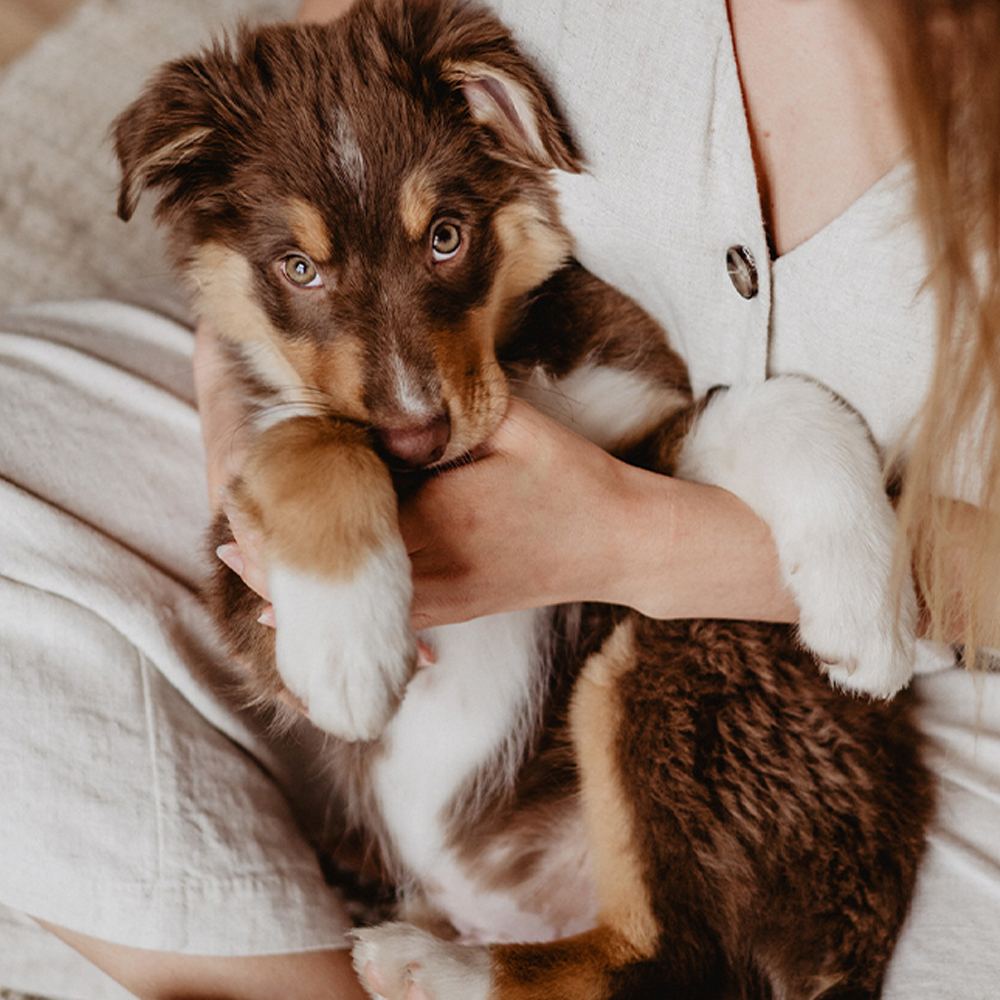Time with your dog - Dog massage to relax
Dog massage - simply relax
You wish yourself and your pet time for relaxation and attention? Here come our 6 massage techniques, which not only strengthen the trust between you and your pet and your bond, but also have a positive effect on your dog's muscles and possible tensions. They can have an antispasmodic, circulation-enhancing and movement-enhancing effect.
Because your dog - like all dogs - has a rear-wheel drive. This means that at the back is the "motor" that propels it forward, in the middle of the body is the transmission and control, and at the very front is where your dog has its shock absorbers and steering. Everything that your pet has to absorb and compensate for during his movements is therefore at the expense of the back and the muscles there.
If you prefer to use all 6 massage units, take about 90 seconds per unit. Always allow 5-15 minutes for a massage on your quadruped.
You need that:
- Massage glove or curry comb
- Cosy dog blanket adapted to the size of your dog
- a comfortable seat cushion for you
- sufficient space
- a quiet atmosphere
Dog massage - how it works
Warm up your hands before the massage and take off your hand and arm jewellery to prevent injuries. Find a quiet and popular place in your flat. Now make yourself comfortable on your pillow and lay your quadruped between your straddled legs directly in front of you on his blanket.
Our tip: The movement of your hands always flows from front to back and from top to bottom along your dog's body. In all techniques, make sure that you never apply pressure directly on the spine and move along the muscles.

1. Deletions
For the introductory strokes you use both hands. Stroke your dog's body slowly with the palms of your hands, applying light pressure. Take care to create flowing transitions and not to release your hands abruptly from the dog's body. You will see from your pet's reaction whether he finds the intensity of your strength pleasant. The introductory stroke is the preparation for the actual massage and warms and loosens the muscles. You can apply these so-called "transitional strokes" before and after each massage technique.
2. Kneading and flexing
For kneading, you use your thumb and index finger on all the muscle groups of your dog, which you can grip all around. These are for example the front and the back legs. To massage, place your thumb on the outside of the leg and your index finger opposite it on the inside and apply light pulsating pressure in small circular movements.
Flexing is done in the middle of the body. As the term suggests, you run with your 4 fingertips in small rotating movements along the muscle groups of your favourite.
3. Friction
In this method of massaging, you work with the ball of your hand in circular movements along the spine of your quadruped. Be careful not to move directly on the spine and only apply light pressure. The ball of your hand is the strongest part of your hand and should therefore be used very carefully.
4. Vibrations
To make your dog's muscles vibrate, you create vibrations with the palm of your hand completely laid out. To do this, shake the palm of your hand with little pressure, quickly and in minimally curved movements to the right and left over your pet's body.
5. Knocks
This massage unit is particularly good for blood circulation. Your fingers are best suited for tapping along your dog's muscles:
- Small dogs: If your quadruped is small and delicate, use the tips of all four fingers.
- Big dogs: If he is rather big and strong, use the hollow tapping, where you grab the ball of your hand with your fingers and tap over your pet's body in this position.
Make sure you use very little force and move your hand max. between 3 and 5 cm away from your dog's body. You should knock about 6 times per second.
6. Massage curry comb/glove
Ride the massage curry comb or massage glove in large circular movements over the entire body of your four-legged friend. As every dog feels the pressure of the currycomb differently, observe how your pet reacts to the use of your strength. You can carefully vary the intensity of the pressure until you have found the right level of application. At the end of the treatment, apply the final strokes, first with the massage bar or massage glove and then with the palm of your hand.
In the run-up to Christmas, treat yourself to such a double time-out every now and then!
How does your pet like the relaxation programme? We are curious about your feedback.
